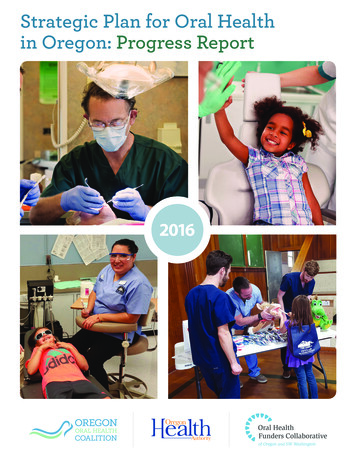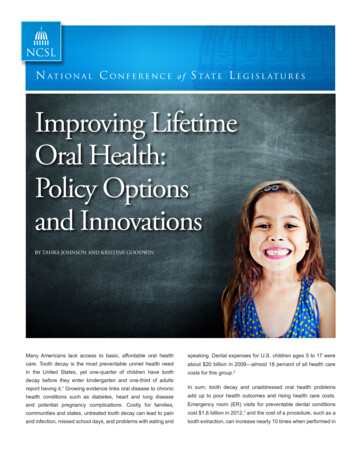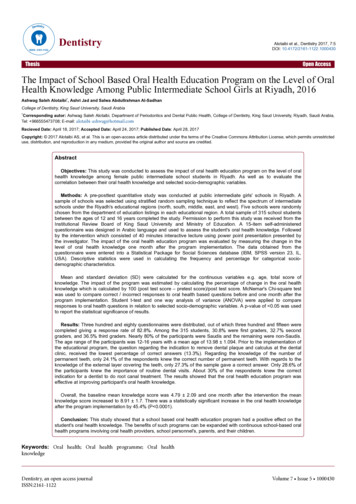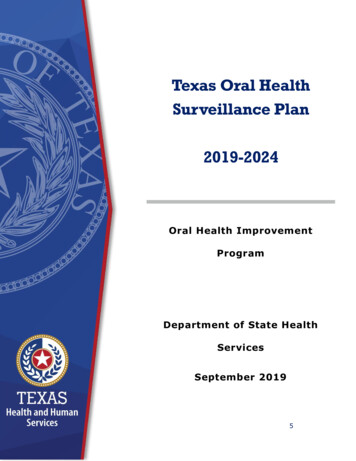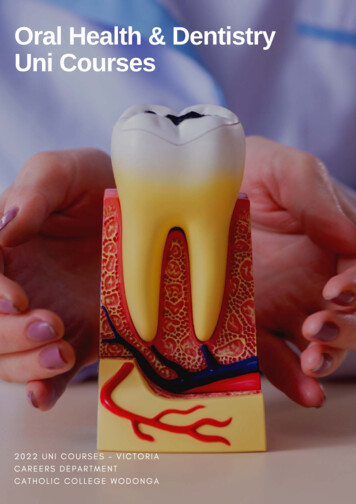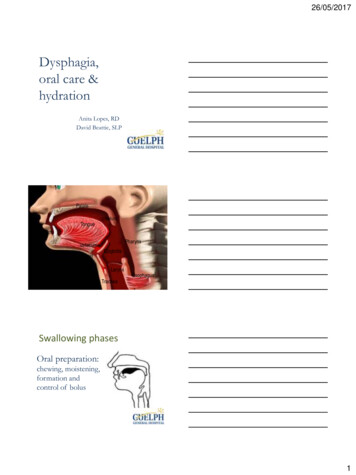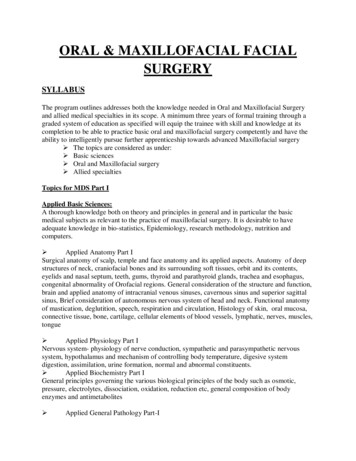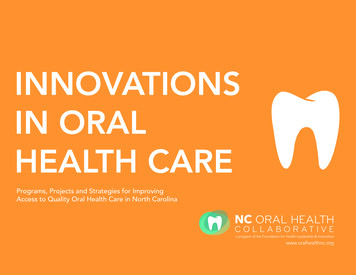
Transcription
INNOVATIONSIN ORALHEALTH CAREPrograms, Projects and Strategies for ImprovingAccess to Quality Oral Health Care in North CarolinaNC ORAL HEALTHC O L L A B O R AT I V Ea program of the Foundation for Health Leadership & Innovationwww.oralhealthnc.org1
Oral Health Innovation TeamKate B. Reynolds Charitable TrustAllen Smart, Vice President of ProgramsNC Oral Health CollaborativeZulayka Santiago, DirectorRhonda Stephens, Research DirectorAlexandra Zizzi, InternNCOHC Collaborative Acceleration TeamInnovation Project DirectorElaine Matthews2
CONTENTSIntroduction p. 5Findings p. 6Key ThemesThe Challenge Going ForwardBaby Oral Health p. 10The UNC School of Dentistry is preparing students to care forinfants and toddlers with the help of a virtual teaching tool.Greene Access Program p. 14The Greene County Dental Clinic is preventing tooth decay in ruralschoolchildren through a program in local elementary schools.School-Based Dental Care p. 19Dental facilities will be built at two Montgomery Countymiddle schools to provide students immediate access to quality care.Children’s Dental Home Sealant Project p. 23A pilot project in Edgecombe and Halifax counties is pairingprivate practice dentists with elementary schools to give childrena healthy dental start.Access Dental Care p. 27A mobile dental team is bringing quality care to disabled patients innursing homes and other special care settings.Dental Care for People with Developmental Disabilities p. 31A pilot project in Buncombe and Dare counties has trained localdental providers to care for patients with developmental disabilities.Physicians Reach Outp. 35A Charlotte-based organization is expanding its successful Physicians Reach Out (PRO)program to include dental care for underserved patients.3
Community Dentist Volunteers p. 39The Good Samaritan Clinic in Morganton is collaborating with private practicedentists to serve low-income, uninsured patients in Burke County.Hospital Partnership p. 43The Dental Clinic of Gaston Family Health Services is collaborating withCaroMont Hospital to provide care for ER patients with dental emergencies.Community Service Learning Centers p. 47The ECU School of Dental Medicine is training dental studentsand treating underserved populations at eight regional dental facilities.Teledentistry in North Carolina p. 51The UNC School of Dentistry is examining the potential for using cutting edgetechnology to increase access to dental care statewide.Virtual Dental Home p. 55A six-year project in California has shown the effectivenessof a community-based strategy for delivering dental care todisadvantaged populations.Virginia Oral Health Coalitionp. 59This Virginia non-profit organization serves as a policy leader and advocate fororal health improvements in the state.AppendixExpanding the Dental Health Workforce To Meet the Needsof Underserved and Vulnerable Populations4p. 62
IntroductionIn 2013, a group of concerned oral health professionals and advocatesjoined together to form the North Carolina Oral Health Collaborative.Their mission was to shape a shared agenda for improving accessto dental care for every person in every part of the state, includingindividuals and families with low incomes, complex health problems,and limited connection to dental health services.One of the goals established by the Oral Health Collaborative inits early days was “to highlight solutions, local and national” to theimmense oral health challenges and to share these solutions with thepeople of North Carolina.To advance this goal, the Kate B. Reynolds Charitable Trust fundeda six-month project to identify exemplary models of oral health care,document those models, and collect the models into a compendium.I was invited to lead this project in coordination with the Oral HealthCollaborative.Over the summer and fall of 2016, I had the privilege of interviewingseveral individuals who are transforming the delivery of dental careand dramatically improving the lives of people in North Carolina andin other states. Some have been innovating for decades. Others arejust getting started. All are creative spirits who are deeply passionateabout their work.Their stories are presented in this report. Each story includes anoverview of the history, purpose, structure, and impact of theprogram, as well as a feature on the innovators themselves. Everyeffort is made to capture the insights and experiences of theinnovators in their own words.I am deeply grateful for the opportunity that the Kate B. ReynoldsCharitable Trust and the NC Oral Health Collaborative have given meto get to know the oral health innovators. These women and men arebeyond inspirational! Together, they are bringing hope, better healthand bigger smiles to thousands who are in need. I am pleased to havethe opportunity to share their stories with you.A special thanks to Members of the NC Oral Health CollaborativeAcceleration Team who provided important guidanceon the selection of model programs to be included inthe report, drawing from their collective knowledge ofthe oral health field. Alexandra Zizzi who prepared the summary of oralhealth workforce programs located in the appendixand conducted extensive background research for theproject. She is a student at the UNC Gillings School ofGlobal Public Health and served as a summer intern forthe Foundation for Health Leadership.Elaine MatthewsCommunications and Policy StrategistDirector, NC Oral Health Innovation ProjectFebruary 20175
Key ThemesThe innovators interviewed for this project share perspectives onmany overarching trends, barriers and opportunities. Key themes fromthe interviews are described below.Adding oral health to the formulafor whole person careSeveral of our innovators applauded the fact that North Carolinais making progress in medical integration, but say that oral healthremains, for the most part, left out of the equation. In some areasof the state, clinics are co-locating medical and dental services toprovide whole person care for their patients. This saves the patienttime, facilitates communication among providers and improvesoverall care. Thanks to North Carolina’s nationally recognized Into theMouths of Babes programs, a number of pediatric practices are nowadding oral health screenings and preventive treatments to well childvisits. Our innovators see these steps as a positive sign. They are alsoencouraged that the conversation about oral health is ramping up atthe national and state levels and hope that this will lead to increasedopportunities for medical-dental integration.Making oral health education a priorityfor North CarolinaAll innovators, regardless of the nature of their work, stressed theextreme importance of dental health education—for patients andtheir families, for health care professionals and caregivers, and for theoverall health of North Carolina’s population. Their concerns ran thegamut—from children who don’t own a toothbrush; to teenagers whorisk losing their teeth due to poor diet and soft drink consumption;to adults who face increased chances of heart disease and diabetesbecause of poor oral health; to seniors and special populations whoare unable to care for their own teeth and have no one to do it forthem.6The innovators said repeatedly that when it comes to a choicebetween food or medicine or dental care, dental care is the first to go.One of the innovators put it this way: “The mouth is a very importantpart of the human body because it often dictates the rest of oursystemic health.” Yet, he lamented, it gets very little attention.Intensifying the focus on preventionThe dental profession has focused on the prevention of tooth decayand gum disease for decades. What is new is the missionary-likezeal with which our innovators and their colleagues are advocatingfor action to ensure all North Carolinians—regardless of income orlocation in the state—gain access to preventive measures. Severalstories in this publication focus on partnerships between dentalprofessionals and public schools that are successfully providingpreventive oral health services for younger children. Along withpreventive measures, they are seeking to connect each child with adental home, whether in a private practice or public clinic. There isalso a growing belief that giving a child a good dental foundationmust start as early as possible—beginning with the health andeducation of the mother before the child is born and good oral healthhabits established during infancy.Breaking through the language barriers and buildingcultural competencyNorth Carolina’s demographic mix is changing rapidly, with the Latinopopulation totaling 890,000 and growing. Given the urgent oral healthneeds among many Latino residents, the innovators are activelydeveloping strategies to meet the needs of this population. Onemodel presented in this publication employs a translation service toensure communications with patients are clear and stress-free. Othersfocus on hiring Spanish-speaking dentists and administrative staff anddistributing oral health materials printed in both Spanish and English.“There is a huge difference in health care systems among cultures,”said one innovator, stressing the importance of cultural understandingand clear communications to overcome the differences. Unfortunately,most dental practices in North Carolina have no provisions forcommunicating with non-English-speaking individuals, leaving thestate far from prepared to handle this challenge.
Medicaid—the elephant in the roomThe innovators were not actively involved in advocating for specificchanges in North Carolina’s Medicaid reimbursement rate or inMedicaid paperwork requirements. But they openly discussed theMedicaid challenges they face daily. Those who have been able toestablish longer term, sustainable programs describe sleepless nightsspent agonizing over funding formulas that will allow their operationsto continue. These formulas often depend on establishing a delicatebalance of patients with employer insurance, patients with Medicaidinsurance and patients who pay a low-cost fee or who are chargedon a sliding scale. The Medicaid reimbursement rate has hoveredaround 40 percent of UCR (usual, customary and reasonable), whichhas served as a major deterrent for many private practice dentists toaccept Medicaid patients in North Carolina and across the nation. Inregard to the broader question of Medicaid expansion, one innovatorcommented that it would make a huge difference. “But until thathappens, we’ve just got to try to make ends meet the best we can.Somebody has to serve our people. They’re hurting.” Clearly, if NorthCarolina is to extend oral health care to all residents in the state,Medicaid must be a major partner.Embracing technology,improving dental practiceAlthough North Carolina has not adopted the advanced teledentistrypractices used in some other states, the state’s oral health leadershipis beginning to explore a range of options. One UNC-Chapel Hilldental surgeon profiled in this publication is leading a large-scaleeffort to determine the potential role for the university in advancedteledentistry. The decade-old ECU School of Dental Medicine hasstate-of-the-art facilities at the Greenville campus and at its regionalcommunity service learning centers, preparing dental students forthe changing world of dentistry. Local innovators report that theyare embracing technologies that fall into two main categories: thosethat allow them to treat patients in nontraditional settings—such aslight-weight, portable x-ray machines—and those that allow dentiststo consult with specialists to speed up and improve diagnosis andtreatment of their patients.Especially eager to gain access to the new technology are dentalprofessionals in rural areas who see it as a way of overcoming distancebarriers and providing their patients with world-class care.Expanding the workforce to meet the needs ofunderserved people and placesNationally, the most hotly debated topic in oral health care is howto increase the number and distribution of qualified oral health careproviders. In spite of well-devised plans and inducements, states likeNorth Carolina still suffer from a severe shortage of dental providersfor large segments of the population. This has led several states topass legislation enabling dental hygienists and other “mid-level”dental professionals to assume expanded, and in some cases, moreindependent roles (without direct oversight of a dentist) in providingprevention services and even treatment. While most of the innovatorsexpressed support for expanded roles, they varied in interpretation.For some, it meant serving as an educator and coordinator of oralhealth services within the community. For others, it meant “beingallowed to work to the full extent of their knowledge and training.”As state leaders consider options for the future, one model worthconsidering is the Virtual Dental Home program that has been testedsuccessfully in California. It is a community-based oral health deliverysystem that uses telehealth technology to link allied dental personnelin remote communities with dentists in private practice and publicclinics.7
Our Challenge Going ForwardFrom a fragmented systemto a statewide visionNorth Carolina is home to fine examples of oral health innovation.This report features programs with strong track records that arenow prime candidates for statewide expansion or replication. It alsoshowcases new ideas, still in the early stages of exploration anddevelopment, which promise to provide future direction for improvingaccess and quality of oral health care.Unfortunately, these innovative programs fail to reach thousandsof North Carolinians who need them. The system of innovationis seriously fragmented, with many programs limited to singleorganizations and single locations. Our innovators are talentedfundraisers and capable managers for programs within their purview.They are not, however, positioned to take their programs to scalestatewide. As a result, benefits accrue to a fortunate few.North Carolina will need to create an environment in whichinnovation can fully advance the delivery of oral health carefor all. This will require an open discussion, evaluation and,as appropriate, revision of state oral health policies to reduceunnecessary constraints and open up opportunities. It also will requirea unified, statewide vision for providing quality oral health care thatembraces and supports innovation.The prospects for the future of oral health care are growingbrighter. The program models featured in this report suggest thatNorth Carolina is indeed fertile ground for innovation in oral health.If we can nurture this innovative spirit, advance sound policy actionand build on our existing resources—namely, world-class academicinstitutions, engaged philanthropic organizations, highly skilledoral health care providers, and passionate advocates—we havethe opportunity to vastly improve the health of our fellow NorthCarolinians.8
“If we can get to kids early,we can change their oralhealth trajectory.”9
Baby Oral HealthA Program of the UNCSchool of DentistryThe NeedIn the 1990s, the medical community underwent a major shift in itsthinking about dental care for young children. For years, the recommended age for a child’s first oral health assessment was age three.Waiting that long, however, meant that some children already haddeveloped cavities. It also meant that the majority of children werenot receiving preventive care that could keep their smile cavity-free inthe future.As a result, the American Academy of Pediatrics (AAP) issued newpolicies in the early 2000s that called for all children to receive an oralhealth risk assessment from a health care provider by six months ofage and to visit a dental home by their first birthday. This guidancepresented a new and challenging role for dentists, in clinics and inprivate practice, who were largely unprepared to serve the needs ofchildren this young.The SolutionEnter Dr. Rocio Beatriz Quinonez, director of the pediatric dentistrypre-doctoral program at the UNC School of Dentistry. Young andenergetic, Dr. Quinonez brought her passion for children and endlesscreativity to the UNC faculty when she accepted the post in 2006. Shesoon became immersed in the school’s work to serve young childrencalled the Baby Oral Health Program (bOHP, pronounced “bop”).10How the Program Works:Baby Oral Health“The Baby Oral Health Program is an effort to prepare the nextgeneration of general dentists to feel comfortable and confident incaring for infants and toddlers,” said Quinonez. Before the programbegan, the school did not have a clinical component in its curriculumfocused exclusively on oral health services for young children. “In theyear we introduced bOHP, 10 percent of our dental class participatedin the clinical experience,” said Quinonez. “Now 100 percent of ourdental students participate.”Students gain their hands-on clinical training at various sites, includingthe Lincoln Community Health Center, a federally-funded healthcommunity center in downtown Durham; the Prospect Hill CommunityHealth Center, a component of Piedmont Health; and the UNCschool-based clinic in Chapel Hill. In these settings, dental studentsbecome skilled in examining infants and advising parents on oralhealth practices for their children.“We believe that if we can get tokids early, we can change their oral health trajectory,” said Quinonez.Students also benefit froma powerful multi-mediateaching tool developed byQuinonez called the BabyOral Health Program Kit.Students can log onto thebOHP website and followa series of step-by-stepThe logo tells it alltraining modules. The kitThe mission of the UNC-CH Baby Oral Healthis rich in content, upbeatProgram, as the colorful logo suggests, is tobring smiles to babies through healthy dentaland visually appealing.practices.It combines in-depthinstructional material withvideos that show how a dentist—working with a baby and caregiver—can conduct exams, administer preventive treatments and providecaregiver education. The kit is compatible with tablets, making it easyfor students to refer to the online training program as they performtheir clinical work.
Students are not the only beneficiaries. Experienced dentistswho are interested in serving the needs of younger children areencouraged to register online and use any or all of the componentsin the kit at any time. The website address is http://www.babyoralhealthprogram.org.How the Program Works:Parental Oral HealthEven though bOHP was widely recognized as groundbreaking,Quinonez believed it was not enough. “We were thinking—if wedo the age one dental visit as advocated,” said Quinonez, “wehave missed the prenatal period when women are much moresusceptible to messages about their oral health and the oral healthof their babies.”It was out of this concern that the Prenatal Oral Health Program(pOHP, pronounced “pop”) was born, a collaboration between theUNC School of Medicine and School of Dentistry. Quinonez workedwith the schools to test a pilot clinical project at community sites,funded by the Blue Cross and Blue Shield Foundation, and then toestablish a prenatal clinic at the School of Dentistry. “Since 2012, wehave trained our dental school classes on the principles of prenataloral health,” said Quinonez. The training has also been madeavailable to medical students who are on clinical rotation at UNCand, since 2014, to the school’s dental hygiene students.To support the prenatal program, Quinonez led in the productionof a second virtual teaching tool, the pOHP kit. Both the clinicalprogram and the pOHP kit are aimed at early dental intervention togive mothers and their children the best opportunity for oral health.“Our goal is for a pregnant woman to be referred to a dentist byher doctor and for the dentist to provide her with a comprehensiveexamination,” said Quinonez, adding that the examination couldsafely include appropriate radiographs. The dentist could thendevelop a treatment plan and share educational slides from thePOHP website that contain key messages, including: It’s safe to have dental treatment when you are pregnant. You can take steps on your own to ensure a healthy mouth duringpregnancy. After your baby arrives, you can take steps to ensure your baby’s oralhealth, including a first dental visit to the dentist by the child’s firstbirthday.The website for POHP is http://www.prenataloralhealth.org.Track Record“The bOHP and pOHP websites are what our students log intoevery time we’re in clinic,” said Quinonez. “We are also pleased thatdentists are using the tools in their practices, although we have nothad the money or time to track that closely. We know that people allover the world are viewing the websites and that academic institutionsin the United States and Canada have adopted the Baby Oral HealthProgram as a component of their teaching programs,” said Quinonez.As far as Quinonez knows, the UNC-developed virtual teaching toolsare the only ones of their kind in the country.FundingFunding for bOHP and pOHP has come from the Blue Cross BlueShield Foundation, the NC Academy of Pediatric Dentists, the NCDental Society, the National Children’s Oral Health Foundation andgifts from individual donors.Looking to the Future“My goal is to keep the train on the tracks,” said Quinonez. “We wantto continue to educate the next generation of dental providers withour mission focused on North Carolina providers, but anybody whowishes to jump on that train is welcome.” She adds that in the futureshe hopes to obtain funds to secure at least a coordinator for theprogram and the websites. She has also been asked to create a phoneapplication to make the tools even more accessible to students anddental professionals.11
Personal Reflections from the InnovatorSpotlight on the Innovator“The students and families we care for are the inspiration in what Ido. I hope that when I’m 80 years old and sipping on my chai latte, Ican look back on a generation of dentists that I helped become moreknowledgeable and comfortable about early childhood oral health.I also hope that the platform we created for prenatal oral care hasbenefited primary care providers and the pregnant women and youngchildren they serve. That’s my hope and dream.”Contact informationDr. Rocio Beatriz QuinonezDepartment of Pediatric DentistrySchool of DentistryUNC CB #7450Chapel Hill, NC 27599-7450(919) 537-3955rocio quinonez@unc.eduRocio Beatriz Quinonez, DDS, MS, MPHAssociate ProfessorDepartment of Pediatric Dentistry and PediatricsUniversity of North Carolina at Chapel HillDr. Rocio Quinonez focuses her abundant energy, creativity anddental expertise on improving the oral health of the nation’s children.Quinonez joined the faculty of the UNC School of Dentistry in2006, where she serves as director of the Pediatric Dentistry PreDoctoral Program, Baby Oral Health Program and Pediatric DentalFaculty Practice. She earned her dental degree from the Universityof Manitoba in Canada and later came to the University of NorthCarolina in Chapel Hill where she performed her pediatric dentistryresidency, received her master’s degree in pediatric dentistry andreceived a master’s degree in health policy and administration.Quinonez was the first UNC faculty member to be awarded theOmicron Kappa Upsilon National Dental Honor Society’s CharlesCraig Teaching Award. The logo tells it all. The mission of the UNCCH Baby Oral Health Program, as the colorful logo suggests, is tobring smiles to babies through healthy dental practices.12
“Going to the dentist is fun.It really is. We’re cool!”13
Greene Access ProgramA Program of GreeneCounty Health CareThe NeedGreene County is a farming community in eastern North Carolina.When the agricultural season is in full swing, the county’s populationof 21,000 increases by several hundred as seasonal workers comein to harvest locally grown crops. The average per capita income inthe county is less than 20,000, and the poverty rate is around 28percent. Dr. Robert “Rob” Doherty, Dental Director of Greene CountyHealth Care, says that the last time statewide dental statistics wereavailable, Greene County ranked 95th in the state for cavities amongkindergarteners and 100th for cavities among children in fifth grade—putting the county at the very bottom of state rankings.The SolutionDoherty and colleague April Wiggins recognized that major stepswere needed to prevent tooth decay in the county’s youngestchildren. Wiggins, a dental hygienist with a passion for children,advocated for starting a dental program in partnership with the localschool system. Doherty began to scout around for program modelsthat were resulting in measurable improvements. One that impressedDoherty was the school program of the Gaston Family Health ServicesDental Clinic, directed by Dr. Bill Donigan. “He worked with oneelementary school that, after three or four years, was caries free,” saidDoherty. “I thought, that’s possible? That’s what got me motivated.”So, Doherty and Wiggins began to develop a strategy for GreeneCounty. They first considered busing the children into the clinic, butdetermined that was not an option due to loss of classroom time forthe students. They also considered going mobile, but the purchase ofa large RV van outfitted with a dental office was expensive.14“So, we decided to go portable,” said Wiggins. “We realized it wasthe most cost effective approach.” By portable, Wiggins means theyuse equipment that can be easily transported from one school site toanother.The next decision point was the type of services to offer. “We workedclosely with school nurses to plan the program, and they advisedus to focus exclusively on preventive services at the school sites,”said Wiggins. “If children needed further treatment, such as fillings,extractions, space maintenance, etc., their parents could drive themto our clinic for services.”The school board approved the final plan in 2013, and the GreeneAccess Program (GAP) was launched. April Wiggins was namedprogram manager.How the Program WorksThe first step in the process is outreach to parents. “At the beginningof the school year, we set up informational booths at all the schools,and everyone who comes by gets a free toothbrush and a toothbrushing chart. We let them know what we’re going to do and thatwe’ll be coming to the school in September or October to provideservices. We make sure we have a Spanish-speaking staff member atthe booth so we can respond to everyone’s questions.”For children to participate in GAP, a parent or guardian must submitsigned paperwork. To make it easier, the paperwork has beenreduced to one sheet and requires only one signature along with aninformational letter. Informational GAP packets are now being sentto parents by email as well as paper. Wiggins knows that sometimespaper does not make it home and that parents tend to be moreattuned to email messages these days.“At the schools, we do cleanings, a full examination by the dentist,x-rays, a fluoride treatment and sealants—all general prevention,”said Wiggins. “Our dentist is great with children and speaks Spanish,which is comforting to some of the younger Hispanic children.”
In many ways, the school clinic is just like any dental office—a skilledstaff working with standard equipment, taking precautions to ensureinfection control. In other ways, things are a bit different. GAP staffwear surgical masks that look like animal faces to keep the childrenentertained. The children lie back in lightweight zero-gravitationchairs for their treatments. And sometimes kindergarteners have acase of the giggles as they wait their turn to see the dentist.Wiggins said they learned a lot during the first year. We’ve gotten alot faster and more efficient and work smarter. We can see 25-30 kidsa day with one doctor and one hygienist.Track RecordBy the end of the 2015-16 school year, GAP had recorded 1,405preventative visits, and dental health providers had placed 1,685sealants on children participating in the program. GAP is now in 12schools—six in Greene and six added in Pitt County in fall 2016.FundingSmiling GAP team is ready for the dayThe Greene Access Program dental team prepares to greet children at G.R.Whitfield Elementary for a morning of dental exams, preventive treatmentsand education on good dental practices.To reinforce the importance of good dental habits, students from theEast Carolina University School of Dental Medicine conduct an oralhealth education program in the classrooms. The program promoteslively engagement of K-5 children with ECU dental students ontopics related to dental health. “It’s a wonderful collaboration,” saidWiggins.Once the GAP team returns to the clinic after a day at a school site,they still have much work to do. They convert student paper recordsto digital files, enter x-rays into the system, and fill out oral healthreport cards (red means cavity) to send to parents. Parents alsoreceive a copy of their children’s charts so they know what needs tobe done. “We give that about two weeks,” said Wiggins. “If we don’thear from the parents, we send out a follow-up letter. If we don’t hearfrom that, we start calling them. It’s a lot of work.”Greene Dental Services started GAP with its own funds. “We didit kind of bare bones. The total cost for the equipment was about 22,000,” said Doherty. Recently, GAP received grant funds from theBlue Cross Blue Shield Foundation to purchase headlamps for thestaff since lighting in schoolrooms is often insufficient for dental work.Funding for the expansion of GAP into Pitt County was provided bythe federal Health Resources and Services Administration. GreeneDental files for Medicaid and offers a sliding fee for parents payingout-of-pocket.Looking to the F
The Good Samaritan Clinic in Morganton is collaborating with private practice dentists to serve low-income, uninsured patients in Burke County. Hospital Partnership p. 43 The Dental Clinic of Gaston Family Health Services is collaborating with CaroMont Hospital to provide care for ER patients with dental emergencies.
